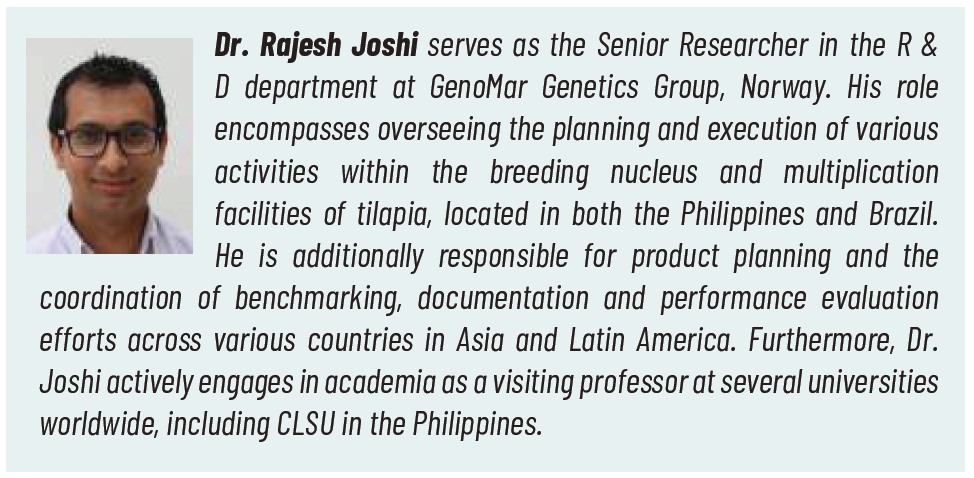Article II 4/2024: UNLOCKING FASTER GENETIC IMPROVEMENT IN TILAPIA THROUGH GENOMICS AND PRECISION BREEDING
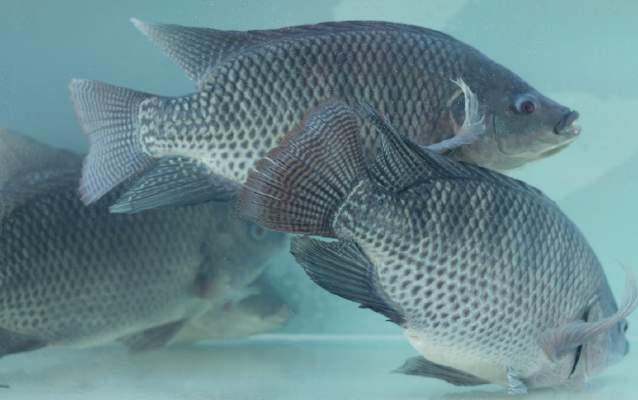
1 FAO. The State of World Fisheries and Aquaculture 2024. Blue Transformation in action. Rome; 2024.
2 Joshi R, Skaarud A, Mariussen A. 30 years of tilapia breeding programs: The effect of traditional and novel selection methods. Aqua Cult Asia Pacific. 2022;18.
The importance of accelerating genetic gain
GenoMar’s selective breeding initiatives have resulted in significant milestones in tilapia breeding, driving the evolution of the global tilapia industry over the past three decades3. This progress has led to the development of tilapia strains and products with superior growth rates compared to the competitors. Field trials have demonstrated that GenoMar fingerlings can help farmers increase both production and profitability by over 30% 4.
3 Joshi R, Skaarud A, Mariussen A. 30 years of tilapia breeding programs: An essential contribution for a healthy and profitable industry. Aqua Cult Asia Pacific. 2021;17:20–4.
4 Joshi R, Fernandes T, Skaarud A, Almeida D, Gil T, Mariussen AV, et al. Impact of genetics in tilapia production - A comparative trial between two strains in Brazil [Internet]. Oslo; 2024. Available from: https://genomar. com/wp-content/uploads/2024/06/Impact-of-genetics-in-tilapia-production.pdf
Each generation in selective breeding brings about remarkable growth enhancements, illustrating the continuous improvement in GenoMar tilapia strains. Since the late 1980s, the company’s breeding program has prioritised fast growth in Asian farming conditions. Leveraging cuttingedge technologies and global expertise, it has established the GenoMar brand as a hallmark of growth performance, benefiting countless farmers worldwide.
Innovations in selective breeding
The rate of genetic progress for a trait is contingent upon several factors, including the number of generations under selection and the precision of selection methods. In GenoMar’s breeding program, early generations focused primarily on fast growth, resulting in substantial advancements with each iteration. As the program matured, additional traits were integrated, such as fillet yield and disease resistance, into the selection criteria5.
5 Joshi R, Skaarud A, Mariussen A. 30 years of tilapia breeding programs: An essential contribution for a healthy and profitable industry. Aqua Cult Asia Pacific. 2021;17:20–4
In the last eight generations, two key innovations have been implemented in the breeding programs (Figure 1). GenoMar is currently harvesting and collecting phenotypes from generation 35 of the breeding population. Genomic selection was fully implemented in Generation 28 and, from generation 31 onwards, combined genomic selection with precision breeding via line breeding. Results have demonstrated tripling of the genetic gain in the last seven generations by implementing these two innovations (Figure 1). Thus, this focused approach increases accuracy and expedites generational turnover, driving rapid advancements and ensuring the continued success of the company’s breeding initiatives.
Figure 1. Relative increase in the estimated breeding values (EBVs) of the trait, weight at 250g, for the last twelve generations of GenoMar tilapia nucleus broodstock6
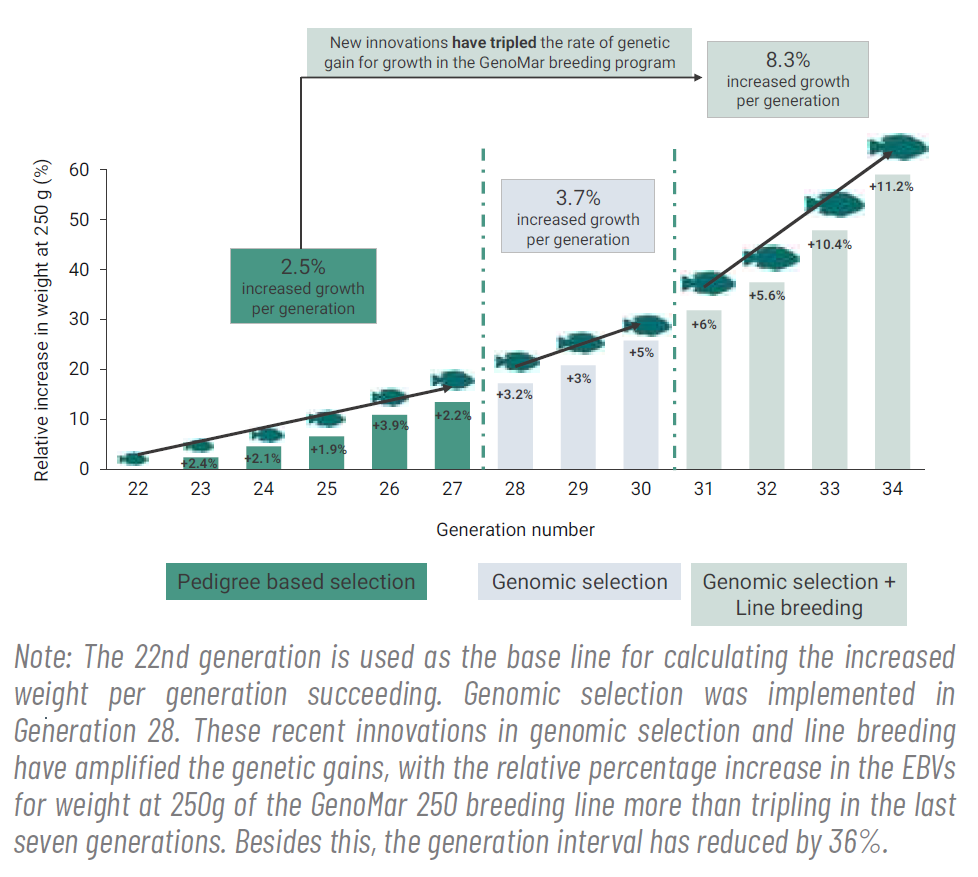
Genomic selection in tilapia breeding programs
Full genomic selection was implemented in the GenoMar strain in early 2019. The process involves dividing offspring into a reference population and selection candidates. The reference population, tested in various environments and for disease resistance, provides phenotype data. Both groups are genotyped, and genomic breeding values are calculated using single nucleotide polymorphism (SNP) effects derived from the reference population. This method ensures precise ranking and selection of the best candidates.
Genotyping tool: high-density SNP chip
Substantial resources have been invested in developing innovative genetic tools aimed at increasing the predictive capabilities in GenoMar breeding programs, ultimately benefiting farmers with superior products. The company’s journey with using DNA information in selective breeding began as early as 2000, culminating in the development of the first high-density SNP array for Nile tilapia (Onil50) in 20167, comprising approximately 58 000 SNPs from the tilapia genome.
Using Onli50 SNP array in the breeding programs for almost six years and testing it on nearly 300 000 tilapia fish, extensive data and insights have been accumulated regarding the performance of various SNPs of the array for the breeding populations. This wealth of information has allowed for the identification and removal of SNPs that are not functioning effectively, while incorporating other important SNPs. As a result, we have updated this to the new version of commercial SNP array, known as the Onil_70 array, for the company’s breeding programs.
7 Joshi R, Arnyasi M, Lien S, Gjoen HM, Alvarez AT, Kent M. Development and validation of 58K SNP-array and high-density linkage map in Nile tilapia (O. niloticus). Front Genet. 2018;9:472.

The updated chip includes 40 000 existing high-quality markers from the previous Onil50 array, alongside approximately 30 000 new SNPs. The SNPs were selected using the in-house reference genome assembly of GenoMar fish developed using both long-read and short-read sequences. This approach provided researchers with the tailored genetic markers specific to the GenoMar strains, ensuring more precision and accuracy in the breeding programs.
Strategic line breeding
To elevate tilapia to the level of “modern aquatic chicken”, GenoMar adopted line breeding techniques, drawing from the poultry industry. Multiple breeding lines align with product portfolios, each focusing on specific traits to meet the global market demands. Strategic crossbreeding of different breeding lines for commercial fingerling production balances performance, combining complementary traits and enhancing productivity beyond parental lines (Table 1). Simulations indicate that line breeding combined with genomic selection will yield an additional 210% genetic gain for GenoMar 250 over the next ten years, positioning GenoMar to become the “aquatic chicken.”
Table 1. Global product strategy based on different breeding lines for various markets in Asia and Latin America
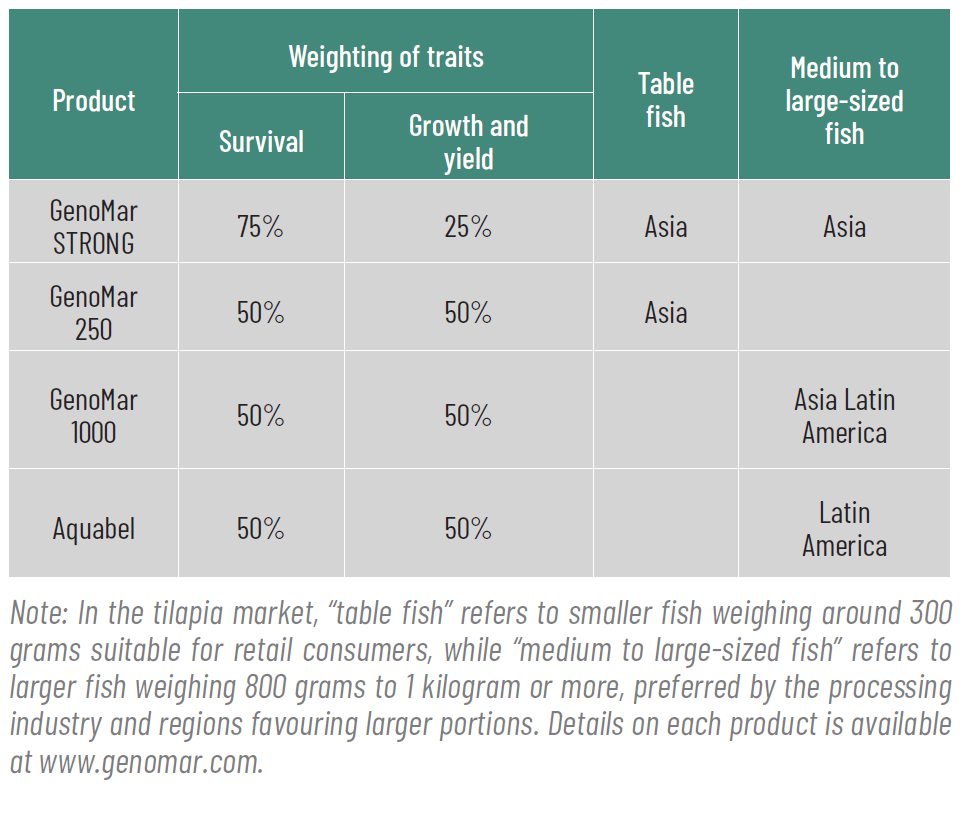
program
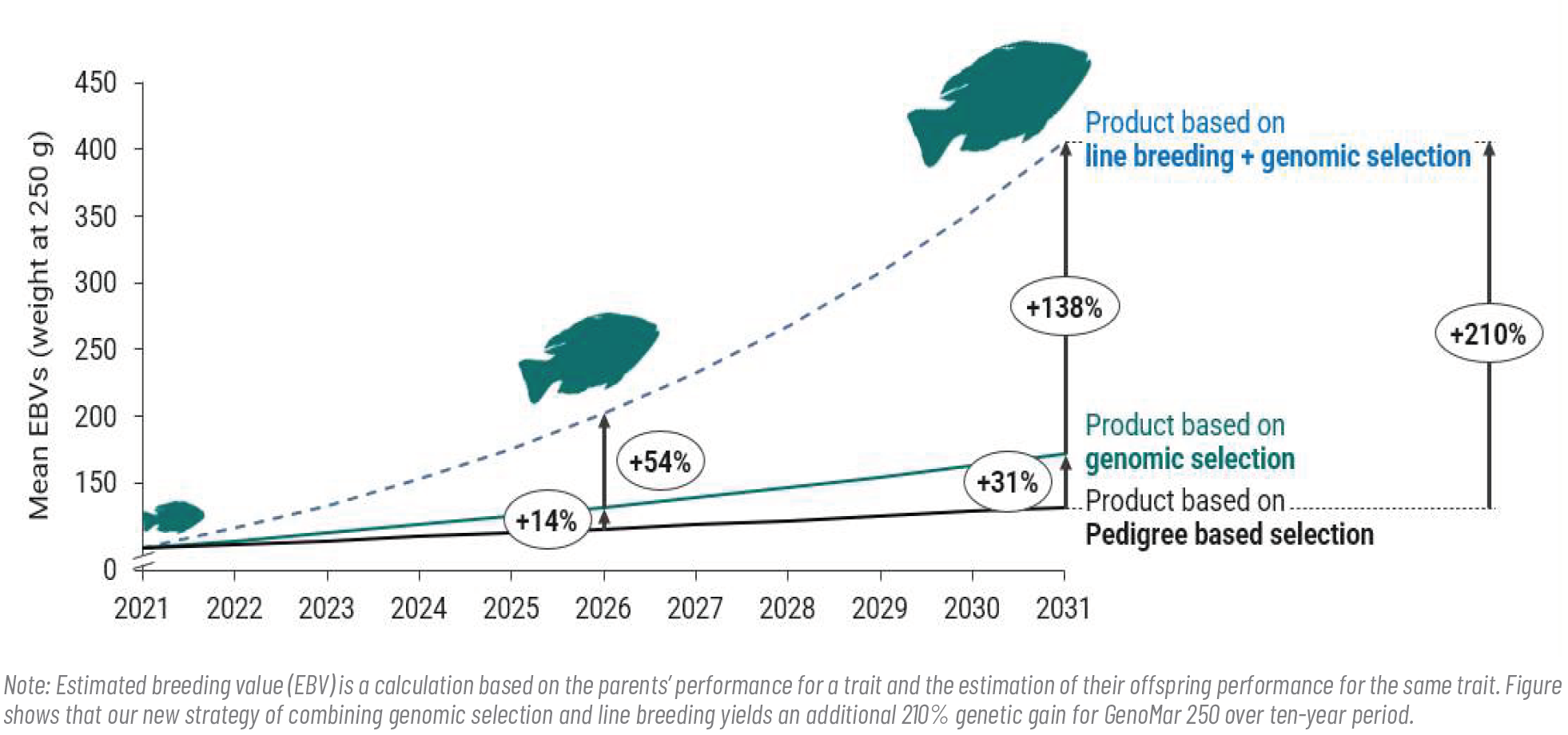
Moreover, the strategic approach to commercial fingerling production using line breeding is designed to elevate the inbreeding levels significantly if competitors incorporate GenoMar commercial fingerlings into their breeding programs (Figure 3). Excessive inbreeding within a fish breeding population can result in inbreeding depression, leading to adverse impacts on growth, fitness, and overall health. This leads to an increased expression of deleterious traits, diminished reproductive success, and a compromised immune system. Such conditions will impact the viability of hatchery operations.
Figure 3: Simulations showing the increase in the inbreeding level within a population resulting from the unauthorised breeding of GenoMar commercial products by competitors

The Food and Agriculture Organization (FAO) recommends that the rate of inbreeding in a population should not exceed 1-3% per generation to maintain the viability of the population. The simulation illustrates that utilising our commercial population for breeding significantly accelerates the inbreeding rate, rendering the breeding nucleus of such competitors non-viable in just a few generations due to the accumulated inbreeding coefficient.
Future prospects and conclusion
The future of tilapia breeding holds significant potential for genetic improvements, enhancing margins for farmers. Selective breeding technologies have evolved significantly over the last century. These technologies require substantial resource investment, which might not be possible for everyone in the market. By leveraging these new technologies, we aim to substantially improve the accuracy of breeding decisions, translating into better products and a more profitable and sustainable tilapia industry. GenoMar’s breeding objective is to supply top-quality fingerlings, supporting healthy, profitable production and value-added products. The goal is to position tilapia as a sustainable alternate protein source, meeting global food demands responsibly and sustainably.
